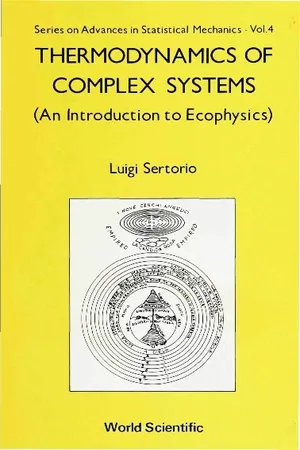
Thermodynamics Of Complex Systems: An Introduction To Ecophysics
An Introduction to Ecophysics
- 220 pages
- English
- PDF
- Available on iOS & Android
Thermodynamics Of Complex Systems: An Introduction To Ecophysics
An Introduction to Ecophysics
About This Book
This book aims at guiding the reader with continuity from the elements of classical equilibrium thermodynamics to the formal problems of global non equilibrium thermodynamics necessary to describe an "active system" such is a thermodynamic ecosystem. To this purpose, the brief review of equilibrium thermodynamics emphasizes the concepts of disequilibrium, Carnot cycles and less efficient cycles, and Gibbs availability as the distance from equilibrium. In this way the reader is taken by hand to accept the concept of Gibbs efficiency of the ecosystem Earth as a property given to us by the cosmological evolution. The final chapters are devoted to the optimal control theory of global non-equilibrium systems. An elementary theory of zero energy thermodynamic automata is presented. A thermodynamic automation with four temperatures and three controls is discussed in detail.
Frequently asked questions
Information
Table of contents
- Index
- Introduction
- Acknowledgments
- 1. 1583; the harmonic oscillator
- 2. Irreversibility is not to be deduced.
- 3. Equilibrium hermodynamics. Irreversibility and reversible processes.
- 4. Equilibrium thermodynamics. Irreversibility and disequilibrium.
- 5. From laboratory to environment.
- 6. Expansion, large scale uniformity and local disequilibrium.
- 7. Reversible, irreversible.
- 8. Time scales.
- 9. The Cosmological engine.
- 10. The equations of non-equilibrium thermodynamics. Rigid systems.
- 11. The equations of non-equilibrium thermodynamics. Fluid systems
- 12. Active Systems
- 13. Ecosystems.
- 14. Ecosystem Earth and the radiation fluxes.
- 15. Ecosystem Earth and its constitution.
- 16. A model for the evaluation of the Earth's availability.
- 17. Comments on section 16.
- 18. Interacting with the ecosystem. Global warming.
- 19. Control and information.
- 20. Brief sketch of one-directional control systems.
- 21. Remarks on global control systems.
- 22. Geophysical inputs.
- 23. Thermodynamics of t h e inert house.
- 24. Variable structure and online automaton Z(4,3).
- 25. Thermodynamic demon and Entropy.
- 26. The intellectual house.
- 27. Conclusions.